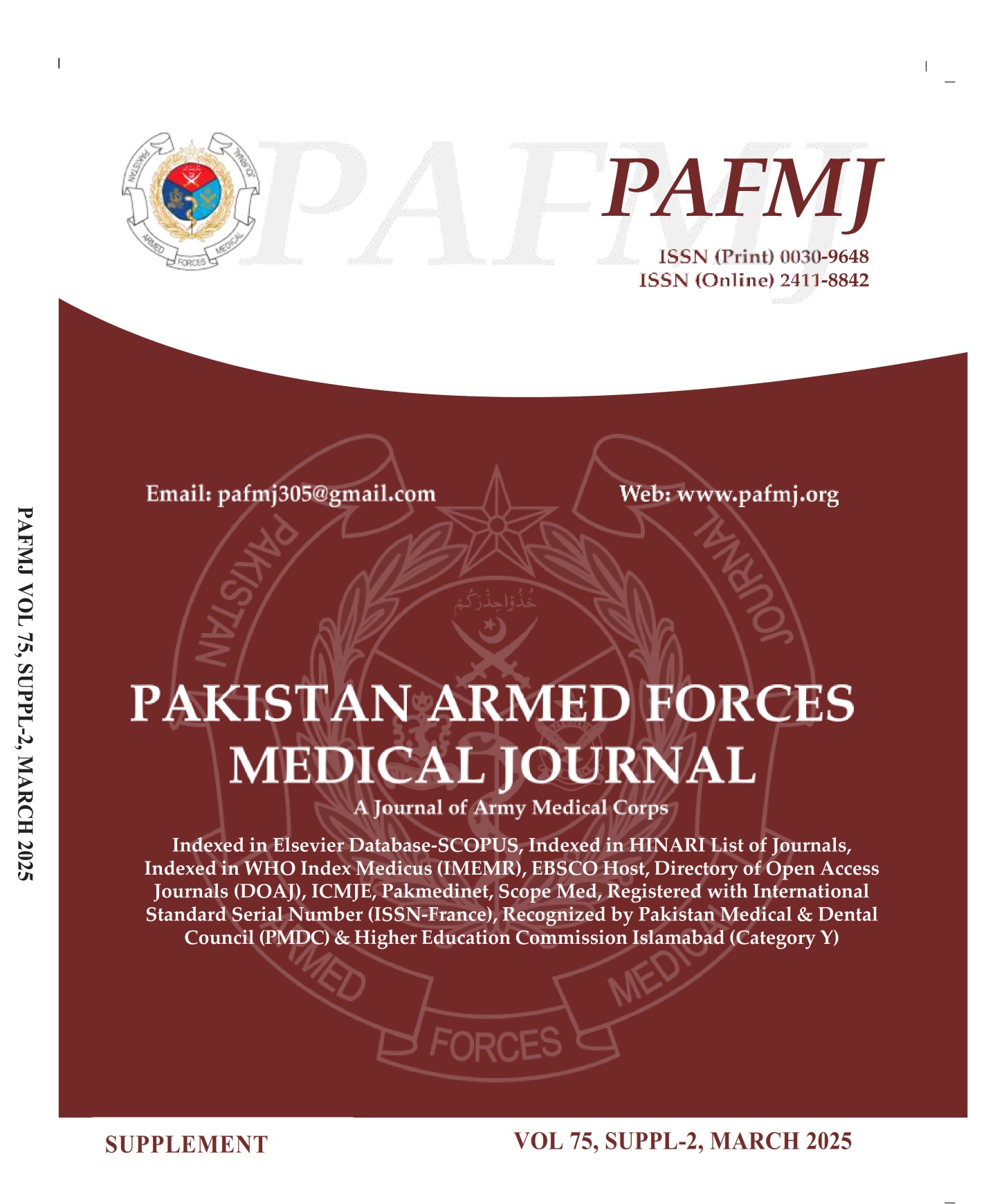Using Pre-Operative Incentive Spirometer Reduces Chances of Basal Atelectasis in Patients Undergoing Upper Abdominal Surgeries - A Randomized Controlled Trial
DOI:
https://doi.org/10.51253/pafmj.v75iSUPPL-2.11141Keywords:
Atelectasis, Preoperative Incentive Spirometry, Upper Abdominal Surgery.Abstract
Objective: To compare frequency of basal atelectasis in patients undergoing upper abdominal surgery who are provided pre-operative incentive spirometry versus those not provided pre-operative incentive spirometry.
Study Design: Randomized controlled trial (NCT06115941).
Place and Duration of Study: Pak Emirates Military Hospital, Rawalpindi Pakistan, from Mar to Sep 2023.
Methodology: We included 74 patients who were scheduled for upper abdominal surgery and divided them into group-A “Pre-op spirometry group” and group-B “no pre-op spirometry group”. Patients who underwent lower abdominal surgery were excluded. Patients were assessed at 48 hours after surgery for presence of basal atelectasis. Data was analyzed by statistical package for social sciences 22.
Results: In our study, mean age of the patients was 37.97±5.36 years. 51(68.92%) male and 23(31.08%) female subjects were included. No significant difference between groups was observed in terms of mean age, gender distribution, mean BMI and median duration of ventilator support (p>0.05). Frequency of basal atelectasis in “incentive spirometry “group-A was 3(8.11%) while in “no incentive spirometry” group-B it was 11(29.73%), (p=0.018).
Conclusion: Although Incentive Spirometry is utilized for management of basal atelectasis but it is also highly useful in reducing frequency of post-op basal atelectasis when used pre-operatively.
Downloads
References
Lim L, Lee J, Hwang SY, Lee H, Oh SY, Kang C, et al. Early postoperative fever and atelectasis in patients undergoing upper abdominal surgery. J Am Coll Surg 2023; 237(4): 606-613.
https://doi.org/10.1097/XCS.0000000000000789
Fischer MO, Brotons F, Briant AR, Suehiro K, Gozdzik W, Sponholz C, et al.; VENICE study group. Postoperative pulmonary complications after cardiac surgery: the VENICE international cohort study. J Cardiothorac Vasc Anesth 2022; 36(8): 2344-2351.
https://doi.org/10.1053/j.jvca.2021.12.024
Zeng C, Lagier D, Lee JW, Vidal Melo MF. Perioperative pulmonary atelectasis: Part I. Biology and mechanisms. Anesthesiology 2022; 136(1): 181-205.
https://doi.org/10.1097/ALN.0000000000003943
Morris K, Weston K, Davy A, Silva S, Goode V, Pereira K, et al. Identification of risk factors for postoperative pulmonary complications in general surgery patients in a low-middle income country. PLoS One 2022; 17(10): e0274749.
https://doi.org/10.1371/journal.pone.0274749
Shahood H, Pakai A, Rudolf K, Bory E, Szilagyi N, Sandor A, et al. The effect of preoperative chest physiotherapy on oxygenation and lung function in cardiac surgery patients: a randomized controlled study. Ann Saudi Med 2022; 42(1): 8-16. https://doi.org/10.5144/0256-4947.2022.8
Östberg E, Thorisson A, Enlund M, Zetterström H, Hedenstierna G, Edmark L. Positive end-expiratory pressure and postoperative atelectasis: a randomized controlled trial. Anesthesiology 2019; 131(4): 809-817.
https://doi.org/10.1097/ALN.0000000000002764
El-Koa AA, Eid HA, Abd Elrahman SR. Value of incentive spirometry in routine management of COPD patients and its effect on diaphragmatic function. Egypt J Bronchol 2023; 17: 8.
https://doi.org/10.1186/s43168-023-00185-7
Kotta PA, Ali JM. Incentive spirometry for prevention of postoperative pulmonary complications after thoracic surgery. Respir Care 2021; 66(2): 327-333.
https://doi.org/10.4187/respcare.07972
Freitas ER, Soares BG, Cardoso JR, Atallah ÁN. Incentive spirometry for preventing pulmonary complications after coronary artery bypass graft. Cochrane Database Syst Rev 2012; 2012(9): CD004466.
https://doi.org/10.1002/14651858.CD004466.pub3
Qiu T, Li Y, Zhang J, Hou X, Wu Y, Xu Y, et al. A cross-sectional study on the application of IS in perioperative pulmonary function training in spine and orthopedics. Comput Intell Neurosci 2022; 4546549. https://doi.org/10.1155/2022/4546549
American Diabetes Association. 2. Classification and diagnosis of diabetes: Standards of medical care in diabetes-2021. Diabetes Care 2021; 44(Suppl 1): S15-S33.
https://doi.org/10.2337/dc21-S002
Flack JM, Adekola B. Blood pressure and the new ACC/AHA hypertension guidelines. Trends Cardiovasc Med 2020; 30(3): 160-164. https://doi.org/10.1016/j.tcm.2019.05.003
Ko E, Yoo KY, Lim CH, Jun S, Lee K, Kim YH. Is atelectasis related to the development of postoperative pneumonia? a retrospective single center study. BMC Anesthesiol 2023; 23(1): 77. https://doi.org/10.1186/s12871-023-02020-4
Doherty RJ, Yolcu YU, Wahood W, Zreik J, Goyal A, Gazelka HM, et al. Is postoperative atelectasis following lumbar fusion more prevalent among patients with chronic opioid use? Clin Neurol Neurosurg 2020; 199: 106308.
https://doi.org/10.1016/j.clineuro.2020.106308
Lagier D, Zeng C, Fernandez-Bustamante A, Vidal Melo MF. Perioperative pulmonary atelectasis: Part II. Clinical implications. Anesthesiology 2022; 136(1): 206-236.
https://doi.org/10.1097/ALN.0000000000004009
Pastene B, Labarriere A, Lopez A, Charvet A, Culver A, Fiocchi D, et al.; GRACE Association. Ultra-early initiation of postoperative rehabilitation in the post-anaesthesia care unit after major thoracic surgery: case-control study. BJS Open 2022; 6(3): zrac063. https://doi.org/10.1093/bjsopen/zrac063
Moradian ST, Heydari AA, Mahmoudi H. What is the role of preoperative breathing exercises in reducing postoperative atelectasis after CABG? Rev Recent Clin Trials 2019; 14(4): 275-279. https://doi.org/10.2174/1574887114666190710165951
Bilyy A, El-Nakhal T, Kadlec J, Bartosik W, Tornout FV, Kouritas V. Preoperative training education with incentive spirometry may reduce postoperative pulmonary complications. Asian Cardiovasc Thorac Ann 2020; 28(9): 592-597.
https://doi.org/10.1177/0218492320957158
Gilani SRA, Hussain G, Ahmad N, Baig MAR, Zaman H. Comparison of post-operative atelectasis in patients undergoing coronary artery bypass grafting with and without pre-operative incentive spirometry. J Postgrad Med Inst 2016; 30(2): 169-172.
Sweity EM, Alkaissi AA, Othman W, Salahat A. Preoperative incentive spirometry for preventing postoperative pulmonary complications in patients undergoing coronary artery bypass graft surgery: a prospective, randomized controlled trial. J Cardiothorac Surg 2021; 16(1): 241.
https://doi.org/10.1186/s13019-021-01628-2
Chang PC, Chen PH, Chang TH, Chen KH, Jhou HJ, Chou SH, et al. Incentive spirometry is an effective strategy to improve the quality of postoperative care in patients. Asian J Surg 2023; 46(9): 3397-3404.
Downloads
Published
Issue
Section
License
Copyright (c) 2025 Muhammad Naeem, Majid Aziz, Bilal Saeed, Syed Daood Hashmi, Muhammad Ali, Meezan Jalil

This work is licensed under a Creative Commons Attribution-NonCommercial 4.0 International License.















